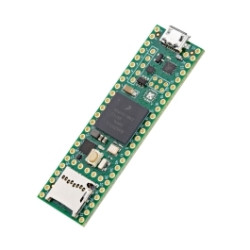Teensy 4.1 without Ethernet
Sparkfun
 RSS
29.60 USD120.26 PLN
RSS
29.60 USD120.26 PLN
- Sklep zagraniczny
- MPN:
- DEV-20359
- Waluta:
- dolar amerykański
- Dodany do bazy:
- Ostatnio widziany:
- Zmiana ceny:
- +43% (26.06.2025)
- Poprzednia cena:
- 20.72 USD
Sugerowane produkty dla teensy4
Meet the Teensy 4.1 without Ethernet, a streamlined version of the popular high-performance development platform. It takes the record-breaking speed of the Teensy 4.0 and expands it for large-scale projects that don't require wired networking. Featuring a similar NXP processor, this board is built around an ARM Cortex-M7 processor running at 600 MHz. This power is supported by 8MB of Flash memory (four times larger than the 4.0) and 1MB (1024K) of RAM. This version omits the Ethernet PHY controller typically found on the standard Teensy 4.1, providing a lower-cost option for applications where Ethernet is not required. It adopts the larger Teensy 3.6 form factor (2.4in x 0.7in) and retains its other powerful I/O capabilities, including a built-in microSD card socket and a USB host port. The Power of the Cortex-M7 Core At the heart of the Teensy 4.1 is the NXP MIMXRT1062DVJ6B, a "Crossover MCU" engineered to bridge the gap between low-cost microcontrollers and high-performance application processors. While it features the same powerful 600 MHz ARM Cortex-M7 core as the Teensy 4.0, this version uses a larger 196-pin package. This expanded pinout is the key to the Teensy 4.1's massive feature set, allowing it to break out all the extra I/O, the SDIO interface, and the USB Host port that the smaller package cannot.
* Dual-Issue Superscalar Processor: The M7 isn't just fast; it's efficient. It can execute two instructions per clock cycle at 600 MHz. Benchmarks show C++ code compiled by Arduino can achieve this dual-instruction execution 40-50% of the time, dramatically accelerating numerically intensive work.
* Branch Prediction: This is the first ARM microcontroller to use branch prediction. Where other microcontrollers (like the M4) waste three clock cycles on loops, the M7's branch predictor learns the loop and removes that overhead, allowing the branch instruction to run in a single clock cycle.
* Hardware FPU: The built-in Floating Point Unit (FPU) crushes math operations. Unlike many microcontrollers that only accelerate 32-bit floats, the Teensy 4.1's FPU provides full hardware acceleration for both 64-bit "double" and 32-bit "float" types. Complex functions like log(), sin(), and cos() are executed at full hardware speed, not through slow software emulation.
Advanced & Expandable Memory Architecture To keep the 600 MHz CPU fed with data, the Teensy 4.1 utilizes Tightly Coupled Memory (TCM). This special feature allows the Cortex-M7 to use 512K of its 1024K total RAM as incredibly fast, single-cycle access memory via a pair of dual 64/32-bit high-speed buses (one for instructions, one for data). The Teensyduino environment automatically allocates your sketch code into this blazing-fast memory. This high-speed access is separate from the main AXI bus, allowing powerful DMA-based peripherals to access other memory with excellent efficiency, thereby minimizing I/O bottlenecks. In addition to the ample onboard memory, the Teensy 4.1 also features two new locations on the bottom of the board for optional soldering of external memory, allowing you to add up to 16MB of PSRAM or a QSPI flash chip for even larger applications. Smart Power Management & Flexibility The Teensy 4.1 is a powerful yet efficient microcontroller, consuming approximately 100mA when running at 600 MHz.
* Dynamic Clock Scaling: You are not locked into one speed. The Teensy 4.1 provides full support for dynamic clock scaling. Unlike traditional microcontrollers, changing the CPU speed on the fly will not break your serial baud rates, audio streaming sample rates, or Arduino timing functions like delay() and millis().
* Power On/Off: For low-power or battery-operated projects, a dedicated On/Off pin allows you to completely disable the 3.3V power supply. Simply connect a pushbutton and hold it for five seconds to power down. A brief press turns it back on.
* RTC Support: If a coin cell is connected to the VBAT pin, the Teensy 4.1’s Real-Time Clock (RTC) will continue to keep track of date and time even when the main power is off.
* Overclocking: For those who push the limits, the Teensy 4.1 is also capable of being overclocked well beyond 600 MHz!
With the processing speed of the Cortex-M7 combined with expanded memory and essential peripherals like a built-in SD slot and USB host port, this Teensy 4.1 is the ideal solution for high-performance projects that don't require network connectivity.
Elecena nie prowadzi sprzedaży elementów elektronicznych, ani w niej nie pośredniczy.
Produkt pochodzi z oferty sklepu Sparkfun